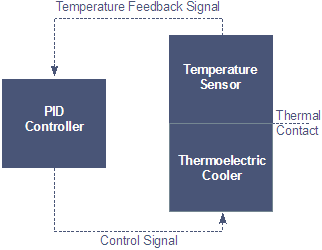Application Tips
Thermoelectric cooler (TEC) is a semiconductor device which is characterized by unique heat pump performance with high efficiency, compactness and durability. The unique ability of TECs to heat and cool, permits them to lower temperature of an object below ambient as well as to stabilize temperature of objects in widely varying ambient conditions.
Here we mention some application tips that can help in optimal use of TECs.
Mounting
Power Supply
Environment
Handling
Heat Dissipation
Reference Data
Brief Summary
PID CONTROLLER
-

-
Close loop DC control is the best solution for TEC operation. It provides most effective use of TECs.
In practice two control methods are in use:
- Proportional-Integral (PI) Control
- Proportional-Integral-Derivative (PID) Control
For most applications PI Control looks is enough. But RMT recommends to use most complex PID control loops.
Usually there is not so much difference in hardware of such two types (PI and PID), only one additional coefficient - a derivative circuit to the PI controller which improves the transient response of such control.
Effectiveness of PID/PI controls depends on correct adjustments of parameters of the Loop:
- Kp, the proportional constant, controls the loop gain.
- Ki, the integral constant, offsets errors.
- Kd, the derivative constant, affects the damping rate.
Calculation of the parameters requires knowing or to examining some specific properties of TEC. One of the methods - Ziegler-Nichols tuning approach.
| Name | Description | Comments |
|---|---|---|
| Process gain | dT/dU (or dT/dI) | Response of the TEC to applied power |
| Time constant | τ | Time constant of controlled system |
| Dead time | τD | Delay of the TEC system response |
By these parameters it is easy to calculate parameters of both PI or PID controls:
| Control Method | Kp | Ki | Kd |
|---|---|---|---|
| PI | 0.9 K | 3.3 τD | — |
| PID | 1.2 K | 2 τD | 0.5 τD |
where K = time constant / (process gain × deadtime) .
In many cases tuning of the PID parameters is done by trials and errors. It is quite long way and requires experience. There are high-end TEC Controllers which provide auto-tuning functions. Even with PID loop parameters obtained this way, final fine tuning is very useful.
Knowledge of object of the control (TEC) is very important for such working. Rough estimations on the basis of the knowledge make PID tuning easier and more effective:
-
Process gain
Roughly estimated value of process gain correlates with maximal performance parameters of a TEC. There are TEc maximal parameters DTmax and Imax or Umax. Thus

Dead time
To estimate value of deadtime it is possible to apply assumptions of most mathematical methods which are used to close loop:

-
Time constant
- RMT provides TEC time constant τTEC in standard specifications.
- Time constant τTEC of a TEC mounted to header or heat sink is doubled (~2 x τTEC).
- If an object is mounted onto cold side of TEC, the time constant becomes considerably higher. It depends on thermal capacity of cooling object:

where C - thermal capacity of the object; ΔT - desired temperature difference; Q - cooling power of TEC.


